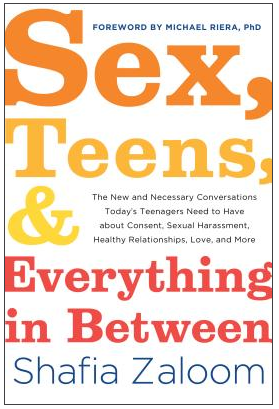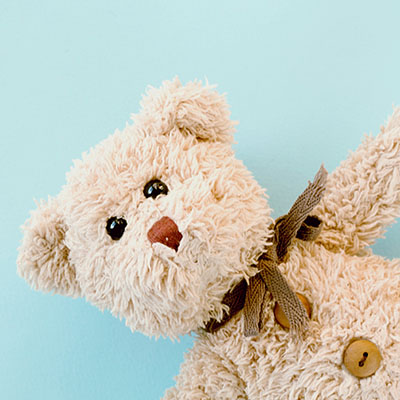Think of a Bear: Talking with Adolescents About Relationships
By Shafia Zaloom | Setpember 10, 2019
Health Educator, Urban School, San Francisco
When talking about sexuality with adolescents, it's often easier to get the message across when you take the sex out of it. This is counterintuitive, I know. So here’s a story, a classroom activity and some examples of classroom discussions with my class that explain the concept.
The engagement youth demonstrate in these interactions tells us they are looking for honest, real-life information; they are thinking about these kinds of issues all the time; and they are eager to learn how to navigate the unique challenges facing their generational cohort.
Shafia’s New Book: Sex, Teens & Everything in Between

See Dr. Pamela Anderson's review of the book on our blog here.
Jaden and Kai
Jaden and Kai are friends in homeroom and have a couple of classes together. The two text often about school-related subjects. Sometimes Jaden ventures a question that's a little more personal, like, “whats up with you?”
One weekend while texting about homework, Jaden goes a little further:
Jaden: hey you want to hang out sometime
Kai: yes
Jaden: yay ;)
Kai’s energy can come across as flirtatious, but Kai assumes this will be time to be with Jaden as friends. Jaden, on the other hand, is interested in exploring a more sexual/intimate connection. The two make plans to hang out at Jaden’s house, and they end up in Jaden’s room, talking about random stuff. Jaden sits down on the bed, pats a spot nearby and asks Kai to sit down.
Kai does, and Jaden puts an arm around Kai. Kai feels a shift in the vibe, realizing, “Jaden is into me. Whoa.” Kai, now uncomfortable, says, “My phone just buzzed. My mom wants me to go home,” and abruptly leaves. Jaden is left feeling confused, frustrated and hurt. The two no longer connect much in class or text about homework. Soon there isn’t any communication at all.
What Just Happened?
The dynamic between Jaden and Kai is common and occurs between people of all genders, sexual orientations, and ages and stages of life. A lack of straightforward communication about intention and expectations can compromise the potential for meaningful connection—whether platonic or romantic.
 It is developmentally expected for young people to explore relationships and sexuality in age-appropriate ways with their peers. However, most adolescents today are steeped in a culture that hyper-sexualizes bodies, glamorizes hooking up without emotional connection, and encourages casual relations and relationship-building through digital devices. Teenagers are socialized to avoid healthy vulnerability, as well as direct and honest in-person communication.
It is developmentally expected for young people to explore relationships and sexuality in age-appropriate ways with their peers. However, most adolescents today are steeped in a culture that hyper-sexualizes bodies, glamorizes hooking up without emotional connection, and encourages casual relations and relationship-building through digital devices. Teenagers are socialized to avoid healthy vulnerability, as well as direct and honest in-person communication.
How can we, as parenting adults and educators, encourage authentic connection, healthy relationships, and effective sexual communication when two teenagers are interested in forming a relationship?
It is essential to help our adolescents, who are concrete thinkers, understand the value of effective communication. They need to know what it actually looks, sounds and feels like when people engage in dialogue that is honest and supportive. The goal is a reciprocal exchange in which we educate others about how to treat us, and listen for how others want to be treated. It is an exchange that is consensual.
In the beginning of my class, we invest significant time in understanding these concepts and exactly what the values we aspire to mean. To highlight the need for this, I ask my students to do an activity called, “Think of a Bear.” It goes like this.
Think of a Bear
“Think of a bear.”
I pause and there are some confused expressions.
“Yes, just think of a bear—the animal.”
Kids start thinking.
“See your bear in your mind’s eye. What it looks like. Where it is. What it’s doing....” We pause. “Okay, now tell us about your bear.”
“A brown bear. Sitting on a tree stump in the woods. It’s cute.”
“A brown bear walking through the forest.”
“Mine is a grizzly fishing in a stream.”
“A black bear hibernating in a cave.”
“A polar bear floating on a piece of disappearing ice.”
“Paddington Bear!”
“Smokey the Bear!”
“A panda bear eating bamboo in the forest.”
“Cute, cuddly Koala!”
“Gummi bears!”
You get the idea. So I ask, “Okay, what’s the take away? What do you notice about your bears?”
“They’re all different!”
 “Yes! We all know what a bear is and could probably have a general conversation about bears, but that doesn't mean our individual ideas about bears look alike. In the same way, when it comes to relationship communication, especially sexual communication, it is really important to not make assumptions about people’s bears. How come?”
“Yes! We all know what a bear is and could probably have a general conversation about bears, but that doesn't mean our individual ideas about bears look alike. In the same way, when it comes to relationship communication, especially sexual communication, it is really important to not make assumptions about people’s bears. How come?”
“If you’re going to agree to something, then you should know exactly what it is so that you understand what someone means and they understand you.”
“Yeah, panda’s aren’t even bears, they’re racoons. So your bear may be totally different from someone else’s, so you aren’t talking about the same thing when you agree.”
“Yes! Okay, so what is it that determines what bear you thought of when I asked? Would your imagination come up with the same bear every time?”
“Probably not. I just saw this film in science about climate change, which is why I thought of a polar bear.”
“I had gummi bears before class, so that’s what I thought of.”
“Yep, context!! Context is everything. What do I mean by context?”
“Your experiences, what you want. What you’re thinking and feeling.”
“Exactly. And that can easily change depending on who we are, what’s going on with us and what’s happening in the environment around us. It’s a variable. That’s why ongoing communication is important, because people have the right to change their minds too. Healthy relationships are grounded in dignity, or feeling valued and treating others like they have value. If we’re going to do that well, we have to make sure we truly understand each other and what each other wants and needs.
“So…when you’re out there in the world and interacting with someone, ask about their bear!”
Discussion: Asking About Someone’s Bear Within a Romantic or Sexual Context
I try to help my students understand, “If you want someone to talk openly about what someone is thinking and feeling, you need to ask questions that allow them to do that. They might say yes, or no, or don’t know, or not right now. The idea is to be empathetic, to avoid judgement, and to recognize the other person's experience as their truth. You have to try to understand what the other person is feeling and reflect that back to them.”
Adolescents need practice with concrete language, too: “How would you feel about X?” “What do you feel comfortable with?” “What feels good for you?” “How would you feel about showing me?” “You good?” “This okay?”
 I encourage teens to stay away from “why,” which can connote judgement and make people feel defensive. When responding, I remind them, “Be honest and straightforward. Remember that how we say something, not just what we say, matters. Body language is a part of our expression. So listen for tone, and if someone is hesitant with their answer, pay attention. Notice body language and whether the person’s words align with what they’re body is expressing. If anything seems off or not right, pause and check in with them.”
I encourage teens to stay away from “why,” which can connote judgement and make people feel defensive. When responding, I remind them, “Be honest and straightforward. Remember that how we say something, not just what we say, matters. Body language is a part of our expression. So listen for tone, and if someone is hesitant with their answer, pay attention. Notice body language and whether the person’s words align with what they’re body is expressing. If anything seems off or not right, pause and check in with them.”
Many teenagers assume that dialogue will be a buzz kill. From what they’ve seen and heard, communication isn't sexy. It’s important for them to understand that healthy sexual exploration is a dialogue. In fact, context, sharing, language and delivery are all part of the experience of communication –and it can be a real turn on, too.
Qualities of a Good Conversation
To illustrate what dialogue in a sexual relationship means, I talk to my students about the Qualities of a Good Conversation, and what that looks like.
I’ll ask, “How many of you have had a quality conversation—a really good one that you felt affirmed by?”
Most hands will go up.
“Okay, so if I were to witness that conversation, what would it look like? I mean body language, facial expressions, tone of voice…”
“People would be open to each other. Leaning in and open. Not with their backs turned or arms folded across them.”
“You would see interest on their faces. And happiness. Or care if it’s a serious conversation.”
“No phones! No distractions—just focus but not in a creepy way. They’re paying attention to each other.”
“Both people give and take the same—there’s balance.”
“Okay, great. And what would the embodied experience of that conversation be? What would it feel like while it was happening?”
“Natural. Like you can trust the person.”
“Yeah, that it’s safe and they won’t go trash talk you.”
“Time doesn’t matter. It’s just passing and you can’t even tell.”
“That they want to understand where you’re coming from. That they care and respect you.”
“It feels good. Even if it’s about something serious. They see you.”
“Great, and what does the conversation leave you feeling?”
“Awesome. Like I’d have it again.”
“Like I grew up some.”
“Satisfied.”
“Yes! Now, how does this kind of good communication relate to sexual communication?”
“It’s the same! It’s ‘Think of a Bear.’ We took the time to really understand each other’s bears!”
It’s About Healthy Relationships
 If the goal is to help our young people develop healthy relationships based on mutual respect, consent, and integrity, these are lessons that start when they are very young. They continue through young adulthood and beyond. We model these kinds of unspoken messages for them every day. We can hope they'll absorb these messages, spoken and not, and take them out into the world and into relationships —both sexual and not.
If the goal is to help our young people develop healthy relationships based on mutual respect, consent, and integrity, these are lessons that start when they are very young. They continue through young adulthood and beyond. We model these kinds of unspoken messages for them every day. We can hope they'll absorb these messages, spoken and not, and take them out into the world and into relationships —both sexual and not.
But we increase our chances of success by using activities such as “Think of a Bear” and having genuine and relevant conversations about how to recognize and practice healthy communications and mutual respect.
Note: The original “Think of a Bear” is something I learned from Dave Mochel of Applied Attention. Since using it in my classes, students have suggested all kinds of metaphors: “think of a butterfly,” “think of a cat,” “think of a tree” and more. Play with it and have fun.
A Resource from the Kirby Summit
Shafia Zaloom was an invited participant in the 2018 Kirby Summit IV convening. Her post is part of a series addressing the ways parents, teachers and other adults can support adolescents in developing healthy relationships—a process called “scaffolding.” Learn more about scaffolding here. Watch for additional resources in future posts on our blog.
Shafia Zaloom is a Health Educator at the Urban School in San Francisco. She is a teacher, former coach and certified outdoor educator and administrator who has worked with thousands of teenagers. Her work has been highlighted by The New York Times, USA Today, PBS and NPR, and she has been an invited participant at ETR’s Kirby Summit. She can be reached through her website here.





